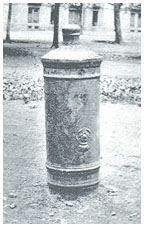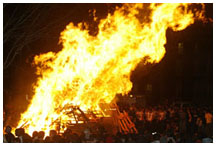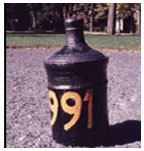|
Web Exclusives: Rally 'Round the Cannon -- Princeton history November 21, 2007: By Gregg Lange ’70 Those of you devoted followers (Hi, Mom!) who thrive on slavish attention to detail have noted the change in the name of the column this fall. It used to be called Under the Ivy, which certainly wasn’t distasteful and did have a nice sense of examining the old mortar and bugs beneath the new greenery. Of course, it also had a faint whiff of clandestine voyeurism that did seem to energize certain elements of the alumni population, but …
Anyhow, the marketing division of PAW solicited voluminous suggestions for alternatives, carefully prepared an unbiased four-page single-spaced questionnaire including mock-up graphics and extensive demographic background data, then grabbed a pencil and sandwich and went out in front of the office on Nassau Street to ask five random passers-by their opinions. Discounting the Labrador retriever, there seemed to be pretty clear enthusiasm for “Rally ’Round the Cannon,” Osborne and Hewitt’s [see my July 18, 2007, column] snappy line from the 1906 “Princeton Cannon Song”: “With cheer and song we’ll rally ’round the cannon as of yore.” It echoes “rally ’round the flag” from the anthem “Battle Cry of Freedom” that (with differing lyrics) was poignantly used by both North and South in the Civil War a generation earlier. This was noted famously by Professor Jim McPherson in his 1988 Pulitzer Prize-winning epic, which was named for the song and is still regarded as the definitive single-volume history of the war. So we rally ’round the cannon, presumably the biggest, most central one buried in the middle of Cannon Green as distinct from the smaller one next to Whig (the object of the Great 1875 Cannon War and the Great 1969 Cannon Hoax) or the third blatantly mounted, as it were, in front of the once-and-future Cannon Club. The Cannon on the Green has been buried there since 1840, and is central to Princeton in just about any sense you can conjure up. You would have to never visit the admission office or take an Orange Key tour and be the nerdiest engineer in history who draws into Forbes College and be unable to ever locate Nassau Street to successfully avoid Cannon Green for four years. Even if you do that, you spend the better part of Class Day with your fellow seniors gathered around it to celebrate yourselves and listen to Bill Cosby or Bill Clinton or somebody justly make fun of you. And of course, if your class is packed with good interior linemen and cornerbacks, you get to celebrate with a bonfire or two during your tenure, a literal highlight of the undergrad experience to anyone who’s ever seen one. After you’ve graduated, a goodly chunk of the P-rade marches by the cannon every year, and the older you get, the more of it you see. So those of you who’ve been staring at it for 40 or 60 or 80 years will be astounded to find out the cannon is sinking. The Excruciating Detail Subcommittee of the Princetoniana Committee (comprising just about all the members, for better or worse) stumbled across this earlier in the year, when the urgent call went out to explain a small flower figure on the cannon-barrel design of a Princeton commemorative spoon. (No, really; I could easily make up a more plausible story than the spoon, right?) It turns out the upside-down figure, clearly shown on old photos of Cannon Green, is a Tudor rose and crown design, indicating the 18th-century cannon was British. But (aha, sleuths!) it’s also clear the rose is no longer visible, according to more recent photos. The cannon is sinking! Circle the wagons, Edna! Donald Farren ’58, Princetoniana’s dedicated vice chairman and proud owner of the telltale spoon, actually constructed a masterful chart documenting cannon de-exposure in 13 separate photographs spanning 120 years – with footnotes – that would do the Baker Street Irregulars proud. The cannon stood about 58 inches high in 1893, 36 inches in 1991, and 25 inches today. The search for the guilty swiftly commenced so the punishment of the innocent could proceed in an orderly way. Cannon Green was accreting! Well, the Nassau Hall basement windows are a little more below ground level than 120 years ago, but nothing like 33 inches. Building and Grounds had reburied it! Calling on their usual calm, strategic view of any earthy issue, B&G quietly allowed as how that was unlikely as there was no such record, leaving unspoken the question of why they would ever even contemplate it. It was being buried in bonfire ash! B&G’s meticulous regrooming of the area afterward and the infrequency of the event (sigh) made this highly questionable. BUT WAIT! Bonfires are not only dirty, they’re … HOT! Thus my current favorite conspiracy theory: The intense temperature of bonfires down through the years has caused the barrel to heat so that it compacted the surrounding soil below ground, and the cannon sank. More logical than blaming Bubba, anyway. This fervid committee discussion played out online
over three months, revealing stark truths about the subterranean
potential of the Internet that would make a pretty good business
school management case or a world-class psycho-geology dissertation.
You’ll be comforted to know as a result of all the hoopla
that the beloved relic is … exactly where it was before. So
thankfully we can still rally ’round the cannon. As of yore,
at least mostly.
To our readers: PAW’s online column on Princeton history, called Under the Ivy since 2002, begins the fall 2007 term with a new name: Rally ’Round the Cannon.
|
|||





 Gregg
Lange '70 is a member of the Princetoniana Committee and the Alumni
Council Committee on Reunions, an Alumni Schools Committee volunteer,
and a trustee of WPRB radio.
Gregg
Lange '70 is a member of the Princetoniana Committee and the Alumni
Council Committee on Reunions, an Alumni Schools Committee volunteer,
and a trustee of WPRB radio.